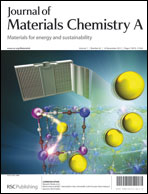Dye-sensitized solar cells based on organic dyes with naphtho[2,1-b:3,4-b′]dithiophene as the conjugated linker†
Abstract
Naphtho[2,1-b:3,4-b′]dithiophene is used for the first time as the π-spacer for metal-free organic dyes in dye-sensitized solar cells (DSSCs). Four new donor–(π-spacer)–acceptor organic dyes using triarylamine or carbazole as the electron-donating group, cyanoacrylic acid as the electron-withdrawing anchoring moiety, and naphtho[2,1-b:3,4-b′]dithiophene as the linker were synthesized. The absorption, electrochemical, and photovoltaic properties of the dyes were investigated. DSSCs based on these dyes as sensitizers had efficiencies ranging from 3.98% to 4.60%. The highest efficiency was 4.60 ± 0.16% with a Jsc of 10.8 ± 0.4 mA cm−2, a Voc of 657 ± 5 mV, and a fill factor of 64.0 ± 0.2% under 100 mW AM 1.5 irradiation. The incident photon-to-current efficiency (IPCE) measurement showed that these dyes had high quantum efficiency over the visible range, and the long π-spacer of the molecule resulted in broader IPCE at long wavelength and high Jsc. Photovoltage transient was used to understand the electron recombination and the trends of the photovoltaic parameters (e.g. Voc and efficiency) of the DSSCs based on these organic dyes.
![Graphical abstract: Dye-sensitized solar cells based on organic dyes with naphtho[2,1-b:3,4-b′]dithiophene as the conjugated linker](/en/Image/Get?imageInfo.ImageType=GA&imageInfo.ImageIdentifier.ManuscriptID=C3TA12901B&imageInfo.ImageIdentifier.Year=2013)

 Please wait while we load your content...
Please wait while we load your content...